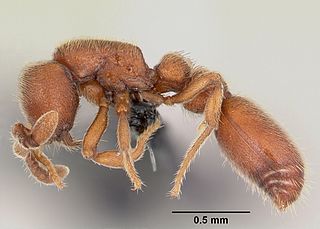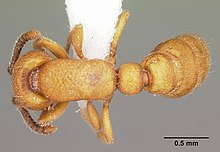
Dorylinae is an ant subfamily, with distributions in both the Old World and New World. Brady et al. (2014) synonymized the previous dorylomorph subfamilies under Dorylinae., while Borowiec (2016) reviewed and revised the genera, resurrecting many genera which had previously been merged. Dorylinae genera are suggested to have evolved sometime between 102 to 74 million years ago, subsequently undergoing rapid adaptive radiation events during their early history.

Ooceraea biroi, the clonal raider ant, is a queenless clonal ant in the genus Ooceraea. Native to the Asian mainland, this species has become invasive on tropical and subtropical islands throughout the world. Unlike most ants, which have reproductive queens and mostly nonreproductive workers, all individuals in a O. biroi colony reproduce clonally via thelytokous parthenogenesis. Like most dorylines, O. biroi are obligate myrmecophages and raid nests of other ant species to feed on the brood.

Anomalomyrma is an Asian genus of ants in the subfamily Leptanillinae. The genus was originally described in 1990 with the type species Anomalomyrma taylori, based on a single dealate queen from Borneo. Workers were unknown until 2011, when two new species were described from Peninsular Malaysia and the Philippines.

Leptanilloides is a genus of ants in the subfamily Dorylinae. Leptanilloides is an uncommonly collected genus with subterranean habits in the New World Andean and sub-Andean tropics.

Labidus is a genus of New World army ants in the subfamily Dorylinae. The genus is known from the United States to Argentina.

Cerapachys is a genus of ants in the subfamily Dorylinae. Species are mainly myrmecophagous ants which raid the nests of other ants for prey. The genus is distributed widely throughout the Indomalayan region. The genus was revised by BoroWiec (2016) who split a number of previously synonymized genera out of Cerapachys, leaving only 5 species in the genus.

Vicinopone is a monotypic Afrotropical genus of arboreal ants in the subfamily Dorylinae. Vicinopone conciliatrix, the only species in the genus, was first described as Simopone conciliatrix by Brown in 1975 and was transferred to its own genus by Bolton & Fisher in 2012. V. conciliatrix appears to be quite widely distributed but rare. Its rarity is more likely apparent than real because it nests and forages in trees, rarely if ever coming down to the ground.

Sphinctomyrmex is a genus of ants in the subfamily Dorylinae. The genus is a tropical and distinctive group, originally described by Mayr based on a single gyne collected in Brazil. Morphologically, the genus is characterized by the unique arrangement of the gastric segments, which are nearly equal in length and separated from each other by distinct constrictions. Very little is known on the natural history of Sphinctomyrmex. The few observations so far suggest that ants of this genus are nomadic predators of other ants. The genus Zasphinctus and approximately 20 species were formerly included, but were split out during revision of the Dorylinae genera by Borowiec (2016).

Stigmatomma mulanae is a species of ant of the genus Stigmatomma. Described by Xu in 2000 from a single dealate queen found in 1998 in the Xishuangbanna Nature Reserve in Yunnan Province, it was placed as the type species of Bannapone, under the name Bannapone mulanae. It was moved to Stigmatomma by Ward & Fisher (2016).

Tyrannomyrmex is a rare tropical genus of ants in the subfamily Myrmicinae. Three similar species, only known from workers, are recognized and share small eyes and edentate mandibles.

Oxyopomyrmex is a genus of ants in the subfamily Myrmicinae.

Zasphinctus is a genus of ants in the subfamily Dorylinae. The genus is a pantropical and distinctive group, originally described by Wheeler (1918) based on "Sphinctomyrmex" turneri collected in Queensland, Australia. Zasphinctus was first described as a subgenus of "Eusphinctus", and then synonymized into Sphinctomyrmex, to later be raised to full genus status by Borowiec (2016), who included approximately 20 species in the new genus circumscription.

Chrysapace is a genus of ants in the subfamily Dorylinae containing four described species. The genus is distributed across the Malaysian peninsula, Indonesia, and the Philippines, with undescribed species from Madagascar and from Baltic amber Chrysapace was described by Crawley (1924) and later placed as a junior synonym of Cerapachys by Brown (1975). Chrysapace was resurrected as a valid genus by Borowiec (2016) during redescription of the doryline genera.

Lioponera is a genus of ants in the subfamily Dorylinae containing approximately 74 described species. The genus is distributed widely across the Afrotropical, Australasia, Indomalaya, Malagasy, and Palearctic bioregions. Lioponera was described by Mayr (1879) and later placed as a junior synonym of Cerapachys by Brown (1975). Lioponera was resurrected as a valid genus by Borowiec (2016) during redescription of the doryline genera.

Ooceraea is a genus of ants in the subfamily Dorylinae containing approximately 16 described species. The genus is distributed across the Australasia, Indomalaya, Malagasy, Neotropical, Oceania, and Palearctic bioregions. Ooceraea was described by Roger (1862) and later placed as a junior synonym of Cerapachys by Brown (1973). Ooceraea was resurrected as a valid genus by Borowiec (2016) during redescription of the doryline genera.

Parasyscia is a genus of ants in the subfamily Dorylinae containing approximately 50 described species. The genus is distributed across the Afrotropical, Australasia, Indomalaya, Malagasy, Oceania, and Palearctic bioregions. Parasyscia was described by Emery (1882), moved to a subgenus of Cerapachys by Forel (1892) and finally placed as a junior synonym of Cerapachys by Kempf (1972). Parasyscia was resurrected as a valid genus by Borowiec (2016) during redescription of the doryline genera.

Syscia is a genus of ants in the subfamily Dorylinae containing thirty eight described species. The genus is distributed widely across the Eastern Asia, North America, and South America. Syscia was described by Roger (1861), later placed as a Cerapachys subgenus by Wheeler (1902) and then junior synonym of Cerapachys by Kempf (1972). Syscia was resurrected as a valid genus by Borowiec (2016) during redescription of the doryline genera.

Neocerapachys is a genus of ants in the subfamily Dorylinae containing 2 described species. The genus is distributed across the Neotropical bioregion in central and South America. Neocerapachys was described by Borowiec (2016) during redescription of the doryline genera.



















